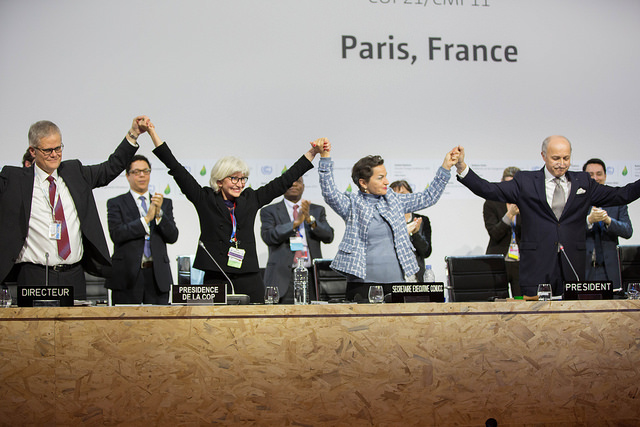As the Paris Agreement enters into force today, it is important to recognize both the significance of this event and the substantial work now required to implement its provisions. While much attention has been given to its goal of limiting the rise in global temperature to “well below 2°C” relative to pre-industrial times, and to pursue efforts to limit warming to a 1.5°C increase, the real significance of the Paris Agreement is that at least 190 countries and the European Union have pledged to reduce their emissions of greenhouse gases (GHGs). These pledges to reduce GHG emissions, called “Nationally Determined Contributions” (NDCs), were the key to achieving nearly universal participation by parties to the United Nations Framework Convention on Climate Change (UNFCCC). Such broad participation was possible because the Agreement allows each country to establish its own target for reducing its greenhouse gas emissions.
 |
| Photo by UNclimatechange |
By themselves, the NDCs are policy documents without the force of law. The NDCs will hold greater promise of being achieved if they, and, more importantly, means for achieving them, are integrated into each nation’s domestic laws. To support the progress of countries in meeting their Paris Climate Agreement goals, the Environmental Law Institute drafted a straightforward model framework for a national-level, climate change law, taking the Paris Agreement as its starting point.
ELI’s model law serves as a resource for countries seeking to implement domestic legislation, giving effect to their NDCs. Because the NDCs may take various forms, ELI’s model law offers several alternative provisions intended to cover the most common approaches. Most countries’ NDCs will include a specific GHG emissions reduction target. Countries may achieve those targets through a variety of measures, including industry-specific emissions reductions, cap-and-trade market-based systems, carbon taxes, energy-efficiency investments, and more. Some NDCs may also include a carbon sink goal or state their intent to include land and forest sectors in their GHG inventories. The model law also includes provisions for reporting and information collection, accountability and enforcement, and adaptation. And it includes “drafting notes” to assist countries in tailoring legislation specific to their needs.
The model law does not attempt to provide specific provisions addressing all possible scenarios, and does not prefer one approach over another. Rather, it simply seeks to enshrine NDCs, whatever their form, as a domestic law commitment in order to increase their chances of being successfully implemented.
